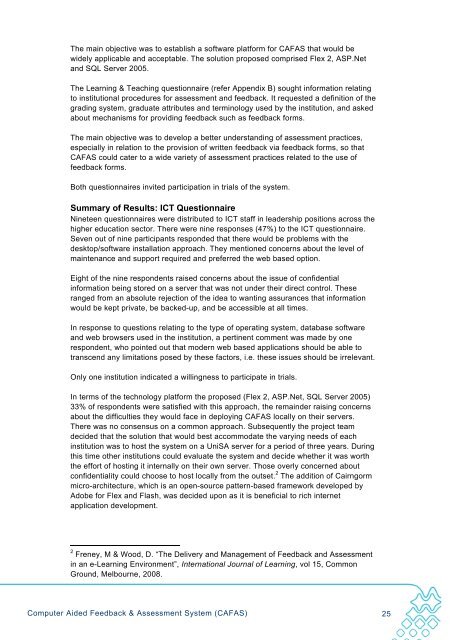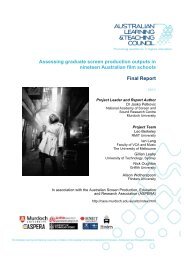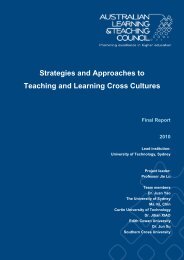PP654 UniSa Freney - Final Report Feb 2010.pdf - Office for ...
PP654 UniSa Freney - Final Report Feb 2010.pdf - Office for ...
PP654 UniSa Freney - Final Report Feb 2010.pdf - Office for ...
You also want an ePaper? Increase the reach of your titles
YUMPU automatically turns print PDFs into web optimized ePapers that Google loves.
The main objective was to establish a software plat<strong>for</strong>m <strong>for</strong> CAFAS that would bewidely applicable and acceptable. The solution proposed comprised Flex 2, ASP.Netand SQL Server 2005.The Learning & Teaching questionnaire (refer Appendix B) sought in<strong>for</strong>mation relatingto institutional procedures <strong>for</strong> assessment and feedback. It requested a definition of thegrading system, graduate attributes and terminology used by the institution, and askedabout mechanisms <strong>for</strong> providing feedback such as feedback <strong>for</strong>ms.The main objective was to develop a better understanding of assessment practices,especially in relation to the provision of written feedback via feedback <strong>for</strong>ms, so thatCAFAS could cater to a wide variety of assessment practices related to the use offeedback <strong>for</strong>ms.Both questionnaires invited participation in trials of the system.Summary of Results: ICT QuestionnaireNineteen questionnaires were distributed to ICT staff in leadership positions across thehigher education sector. There were nine responses (47%) to the ICT questionnaire.Seven out of nine participants responded that there would be problems with thedesktop/software installation approach. They mentioned concerns about the level ofmaintenance and support required and preferred the web based option.Eight of the nine respondents raised concerns about the issue of confidentialin<strong>for</strong>mation being stored on a server that was not under their direct control. Theseranged from an absolute rejection of the idea to wanting assurances that in<strong>for</strong>mationwould be kept private, be backed-up, and be accessible at all times.In response to questions relating to the type of operating system, database softwareand web browsers used in the institution, a pertinent comment was made by onerespondent, who pointed out that modern web based applications should be able totranscend any limitations posed by these factors, i.e. these issues should be irrelevant.Only one institution indicated a willingness to participate in trials.In terms of the technology plat<strong>for</strong>m the proposed (Flex 2, ASP.Net, SQL Server 2005)33% of respondents were satisfied with this approach, the remainder raising concernsabout the difficulties they would face in deploying CAFAS locally on their servers.There was no consensus on a common approach. Subsequently the project teamdecided that the solution that would best accommodate the varying needs of eachinstitution was to host the system on a UniSA server <strong>for</strong> a period of three years. Duringthis time other institutions could evaluate the system and decide whether it was worththe ef<strong>for</strong>t of hosting it internally on their own server. Those overly concerned aboutconfidentiality could choose to host locally from the outset. 2 The addition of Cairngormmicro-architecture, which is an open-source pattern-based framework developed byAdobe <strong>for</strong> Flex and Flash, was decided upon as it is beneficial to rich internetapplication development.2 <strong>Freney</strong>, M & Wood, D. “The Delivery and Management of Feedback and Assessmentin an e-Learning Environment”, International Journal of Learning, vol 15, CommonGround, Melbourne, 2008.Computer Aided Feedback & Assessment System (CAFAS) 25
















